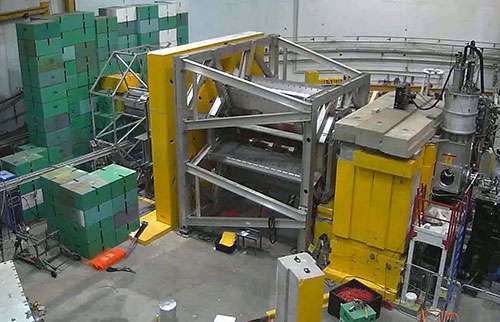Proton weak charge determined for first time: Initial Q-weak experiement results

(Phys.org) —Researchers have made the first experimental determination of the weak charge of the proton in research carried out at the Department of Energy's Thomas Jefferson National Accelerator Facility (Jefferson Lab).
The results, accepted for publication in Physical Review Letters, also include the determinations of the weak charge of the neutron, and of the up quark and down quark. These determinations were made by combining the new data with published data from other experiments. Although these preliminary figures are the most precise determinations to date, they were obtained from an analysis of just 4 percent of the total data taken by the experiment, with the full data analysis expected to take another year to complete.
The weak force is one of the four fundamental forces in our universe, along with gravity, electromagnetism and the strong force. Although the weak force acts only on the sub-atomic level, we can see its effects in our everyday world. The weak force plays a key role in the nuclear reaction processes that take place in stars and is responsible for much of the natural radiation present in our universe.
The Q-weak experiment was designed by an international group of nuclear physicists who came together more than a decade ago to propose a new measurement at Jefferson Lab. They proposed the world's first direct measurement of the proton's weak charge, denoted by the symbol Q_W^p; this represents the strength of the weak force's pull on the proton, a measure of how strongly a proton interacts via the weak force. Since the weak charge of the proton is precisely predicted by the Standard Model, which is a well-tested theoretical framework that describes the elementary particles and the details of how they interact, it is an ideal parameter to measure experimentally as a test of the Standard Model.
To perform the experiment, the scientists directed a very intense beam of electrons into a container of liquid hydrogen. The electrons were longitudinally polarized (spinning along or opposite their direction of motion). Electrons that made only glancing collisions with the protons (elastic scattering, where the proton remained intact) emerged at small angles and were deflected by powerful electromagnets onto eight symmetrically placed detectors.
The weak force is far weaker than the electromagnetic force. In classical terms, one might think of this as for every one million electrons that interact with the protons via the electromagnetic force, only one will interact via the weak force. Physicists measured those few weak interactions by exploiting an important difference between the two forces - the weak force violates a symmetry known as parity, which reverses all spatial directions and turns our right-handed world into a left-handed one. In an opposite-parity world, the electrons spinning with their axes along their direction of motion would interact with protons via the electromagnetic force with the same strength. Where the weak force is concerned, electrons with right-handed spin interact differently than left-handed ones. By keeping all other parameters of the experiment the same, and only reversing the polarization direction of the electron beam, scientists can use the difference or "asymmetry" of the measurements between two polarization directions to isolate the effect of the weak interaction. The goal is to measure this difference, only ~200 parts per billion, as precisely as possible. This precision is equivalent to measuring the thickness of a sheet of paper laid atop the Eiffel Tower.
The initial analysis of the Q-weak experimental data yielded a value for Q_W^p that is in good agreement with the Standard Model prediction. However, the collaboration has 25 times more data than was used in this initial determination. The final result should provide a rigorous experimental test of the Standard Model, providing constraints on new physics at the scale of energies being explored at the Large Hadron Collider at CERN in Europe.
"Readers should view this result primarily as a first determination of the weak charge of the proton. Our final publication will be focused on implications with respect to potential new physics," says Roger Carlini, a Jefferson Lab staff scientist and spokesperson for the Q-weak Collaboration.
The Q-weak experiment was originally approved in January 2002. A nearly year-long installation period for experimental equipment began in 2009, which was followed by a two year period of data collection during 2010-2012.
Numerous technical achievements in the last decade made this experiment possible. These include the high-current, high-polarization, extremely stable electron beam provided by Jefferson Lab's Continuous Electron Beam Accelerator Facility; the world's highest-power cryogenic hydrogen target; extremely radiation-hard Cerenkov detectors; ultra-low noise electronics to read out the signals and precisely measure the beam current; and a system which measures the beam polarization to better than 1 percent using a back-scattered laser. These technical achievements have yielded an astonishingly small total uncertainty of 47 parts per billion for the data published so far.
More information: The results will be published in Physical Review Letters online on Oct. 13 and in print on Oct. 18.
Journal information: Physical Review Letters
Provided by Thomas Jefferson National Accelerator Facility




















